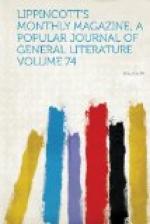During one of M. Garnier’s excursions into the interior he came across one of the sacred groves where the natives bury their dead, if hanging them up in trees can be so designated. His guides all refused to accompany him, fearing to excite the anger of the manes of their ancestors. He therefore entered the high grove alone. Numerous corpses, enveloped in carefully-woven mats and then bound in a kind of basket, were suspended from the branches of the trees. Some of these were falling in pieces, and the ground was strewn with whitened bones. It seems strange that this form of burial should be chosen in a country where at least once a year there occurs a terrible cyclone that destroys crops, unroofs houses, uproots trees, and often sends these basket-caskets flying with the cocoanuts through the air.
In New Caledonia there are no ferocious beasts, and the largest animal is a very rare bird which the natives call the kagon. When, therefore, they saw the English eating the meat from beef bones they inferred that these were the bones of giants, and naively inquired how they were captured and what weapons of war they used. The confidence and admiration of these children of Nature are easily gained, and under such circumstances they talk freely and delight in imparting all the information they possess. Among one of the tribes near Balarde, M. Garnier noticed a young woman of superior beauty, and made inquiries about her. This was Iarat, daughter of the chief Oundo. The hornlike protuberances on her head were two “scarlet flowers, which were very becoming in her dark hair.”
[Illustration: Iarat, daughter of the chief Oundo.]




